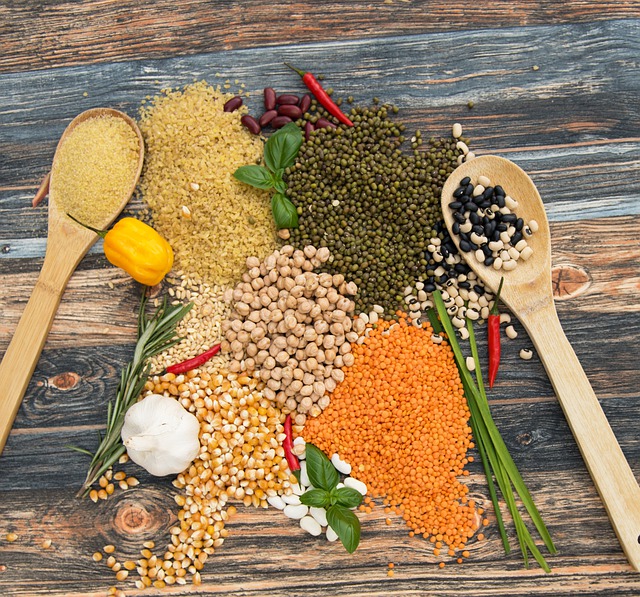Antinutrients Part One: Lectins
 You will occasionally hear someone state that one should not eat a diet rich in legumes, whole grains, or seeds. These individuals will cite fears of anti-nutrients that cause more damage than the product will deliver. One of those commonly described are lectins.
You will occasionally hear someone state that one should not eat a diet rich in legumes, whole grains, or seeds. These individuals will cite fears of anti-nutrients that cause more damage than the product will deliver. One of those commonly described are lectins.
The use of “disgust “ about food is a common tactic to either prevent people from eating certain foods or food groups. To state that a food, or a product, when ingested will cause problems gives anyone pause. In the case of lectins this is used commonly to either promote some product to prevent issues, or to promote a dietary intervention they sell, or even to promote themselves as a “true” lifestyle coach.
Making lectins an object of disgust have been used to promote diets that are lectin free (Paleo) or sell products that allow you to eat them without consequence, or self-promote various lifestyle coaches that they have this “special knowledge” and advocate their clients to avoid these types of food, separating them from the majority of registered dieticians and physicians promote healthy diets of whole grains, legumes, seeds, and nuts.
What Are Lectins?
Lectins are proteins that are found in plants, animals, and even microorgansms. They are glyco-proteins, or carbohydrate-binding proteins, that are most famous for being called hemagglutinins. They bind to specific carbohydrates on cells and result in red blood cell agglutination. Over 500 of lections have been identified in nature.
But in food they are often talked about in plants, specifically legumes, seeds, nuts, fruits and vegetables and are sometimes referred to as “anti-nutrients.” While the amounts found in fruits and vegetables are negligible (and meats even less) they are more concentrated in legumes and grains. Phaseolus vulgaris, also the common bean lectins and wheat germ agglutinin have been well studied. To study them they are found by their activity against red blood cells and often you will hear that soybeans have the highest levels followed by beans, lentils, peas, fava beans and chickpeas (1). But the lectin content can vary widely depending upon the part of the world.
Lectins are not broken down in the stomach or the intestines but they are denatured by soaking, baking, and boiling. This is why many times we advocate not eating these items raw. If you eat beans raw, or legumes you will get the equivalent of food poisoning. If you eat them cooked they do not cause that issue.
The question is – how bad are they. In the popular press you will hear everything from never eating beans and legumes, to purchasing magical potions that inactivate the lectins and protect you from having them (there is no compound that functions as a shield against lectins).
These lectins (as found in raw forms) have been shown to bind to the intestine and cause issues with permeability and inflammatory activity which impairs nutrient absorption of proteins, fats, and vitamin B12. In some animals it even causes reduced growth (not ever demonstrated in humans).
Why Legumes, Seeds, and Whole Grains are Healthy
Here is the good news: when fed a legume rich diet there is actually a reduced rate of absorption of carbohydrates, a lowered level of glycemic responses and insulinemic responses which lead to lower rates of inflammatory markers. In other words, eating legumes seems to not only provide a good source of fiber and protein, but a good way to decrease other calories.
Much like Whole Grains lead to decreased inflammatory markers but refined grains lead to inflammatory markers – cooking clearly changes the properties of the legumes, grains, and seeds – and so does soaking (hence, overnight oats with chia seeds and the rolled oats leads to less inflammation).
In the Nurses’ Health Study, where they followed 73,710 nurses from 1984-2012, the 92,329 women in NHS2 (1991 to 2013), and 43,259 men in Health Professionals Follow-up Study (1986 to 2012), free of chronic diseases at baseline they found that these plant based diets are correlated with a reduction in coronary heart disease.
This is similar in findings of the DASH diet, high in legumes and whole grains, was found to have less incidence of coronary heart disease and stroke.
There is even evidence that lectins can be used as an anti-cancer adjuvant therapy and they have been found to have some activity against a few cancers in tissue culture. No human studies have been done, but that won’t stop someone from making the anti-cancer claim.
What we know is that if foods are not prepared properly people can get food poisoning. But, soaking, sprouting, fermenting, cooking all make these not only palatable but safe for human consumption.
References:
Liu R.H. Potential synergy of phytochemicals in cancer prevention: Mechanism of action. J. Nutr. 2004;134:3479S–3485S. doi: 10.1093/jn/134.12.3479S
Schulze M.B., A Martinez-Gonzalez M., Fung T.T., Lichtenstein A.H., Forouhi N.G. Food based dietary patterns and chronic disease prevention. BMJ. 2018;361:k2396. doi: 10.1136/bmj.k2396.
Trichopoulou A., Kyrozis A., Rossi M., Katsoulis M., Trichopoulos D., La Vecchia C., Lagiou P. Mediterranean diet and cognitive decline over time in an elderly Mediterranean population. Eur. J. Nutr. 2014;54:1311–1321. doi: 10.1007/s00394-014-0811-z.
Bechthold A., Boeing H., Schwedhelm C., Hoffmann G., Knüppel S., Iqbal K., De Henauw S., Michels N., Devleesschauwer B., Schlesinger S., et al. Food groups and risk of coronary heart disease, stroke and heart failure: A systematic review and dose-response meta-analysis of prospective studies. Crit. Rev. Food Sci. Nutr. 2017;59:1071–1090. doi: 10.1080/10408398.2017.1392288.
Dinu M., Abbate R., Gensini G.F., Casini A., Sofi F. Vegetarian, vegan diets and multiple health outcomes: A systematic review with meta-analysis of observational studies. Crit. Rev. Food Sci. Nutr. 2016;57:3640–3649. doi: 10.1080/10408398.2016.1138447.
Whalen K.A., Judd S., McCullough M.L., Flanders W.D., Hartman T.J., Bostick R.M. Paleolithic and Mediterranean Diet Pattern Scores Are Inversely Associated with All-Cause and Cause-Specific Mortality in Adults. J. Nutr. 2017;147:612–620. doi: 10.3945/jn.116.241919.
Gibson R.S., Raboy V., King J.C. Implications of phytate in plant-based foods for iron and zinc bioavailability, setting dietary requirements, and formulating programs and policies. Nutr. Rev. 2018;76:793–804. doi: 10.1093/nutrit/nuy028.
Gautam A.K., Sharma D., Sharma J., Saini K.C. Legume lectins: Potential use as a diagnostics and therapeutics against the cancer. Int. J. Boil. Macromol. 2020;142:474–483. doi: 10.1016/j.ijbiomac.2019.09.119.
Nciri N., Cho N., Bergaoui N., El Mhamdi F., Ben Ammar A., Trabelsi N., Zekri S., Guémira F., Ben Mansour A., Sassi F.H., et al. Effect of White Kidney Beans (Phaseolus vulgarisL. var. Beldia) on Small Intestine Morphology and Function in Wistar Rats. J. Med. Food. 2015;18:1387–1399. doi: 10.1089/jmf.2014.0193.
ChavezMendoza C., Chávez E.S. Bioactive Compounds from Mexican Varieties of the Common Bean (Phaseolus vulgaris): Implications for Health. Molecules. 2017;22:1360. doi: 10.3390/molecules22081360.
Monk J.M., Zhang C.P., Wu W., Zarepoor L., Lu J.T., Liu R., Pauls K.P., Wood G.A., Tsao R., Robinson L.E., et al. White and dark kidney beans reduce colonic mucosal damage and inflammation in response to dextran sodium sulfate. J. Nutr. Biochem. 2015;26:752–760. doi: 10.1016/j.jnutbio.2015.02.003
Hartman T.J., Albert P.S., Zhang Z., Bagshaw D., Kris-Etherton P.M., Ulbrecht J., Miller C.K., Bobe G., Colburn N.H., Lanza E. Consumption of a legume-enriched, low-glycemic index diet is associated with biomarkers of insulin resistance and inflammation among men at risk for colorectal cancer. J. Nutr. 2009;140:60–67. doi: 10.3945/jn.109.114249.
Masters R.C., Liese A.D., Haffner S.M., Wagenknecht L.E., Hanley A.J. Whole and Refined Grain Intakes Are Related to Inflammatory Protein Concentrations in Human Plasma. J. Nutr. 2010;140:587–594. doi: 10.3945/jn.109.116640
Dueñas M., Sarmento T., Aguilera Y., Benitez V., Mollá E., Esteban R.M., Martin-Cabrejas M.A. Impact of cooking and germination on phenolic composition and dietary fibre fractions in dark beans (Phaseolus vulgaris L.) and lentils (Lens culinaris L.) LWT. 2016;66:72–78. doi: 10.1016/j.lwt.2015.10.025
Satija A, Bhupathiraju SN, Spiegelman D, Chiuve SE, Manson JE, Willett W, Rexrode KM, Rimm EB, Hu FB. Healthful and Unhealthful Plant-Based Diets and the Risk of Coronary Heart Disease in U.S. Adults. J Am Coll Cardiol. 2017 Jul 25;70(4):411-422. doi: 10.1016/j.jacc.2017.05.047. PMID: 28728684; PMCID: PMC5555375.
Fung TT, Chiuve SE, McCullough ML, Rexrode KM, Logroscino G, Hu FB. Adherence to a DASH-style diet and risk of coronary heart disease and stroke in women. Arch Intern Med. 2008 Apr 14;168(7):713-20. doi: 10.1001/archinte.168.7.713. Erratum in: Arch Intern Med. 2008 Jun 23;168(12):1276. PMID: 18413553.
Gupta R, Wood DA. Primary prevention of ischaemic heart disease: populations, individuals, and health professionals. Lancet. 2019 Aug 24;394(10199):685-696. doi: 10.1016/S0140-6736(19)31893-8. PMID: 31448740.
Egolf A, Siegrist M, Hartmann C. How people’s food disgust sensitivity shapes their eating and food behaviour. Appetite. 2018 Aug 1;127:28-36. doi: 10.1016/j.appet.2018.04.014. Epub 2018 Apr 19. Erratum in: Appetite. 2019 Feb 1;133:441. PMID: 29680195.
